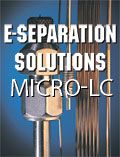Professor Walter Goodrich Jennings: A Remembrance
E-Separation Solutions
We note here the passing of pioneering American gas chromatographer Walter G. Jennings on July 5, 2012. Walt, as he preferred, died peacefully at home surrounded by family. He was 90 years old.
We note here the passing of pioneeringAmerican gas chromatographerWalter G. Jenningson July 5, 2012. Walt, as he preferred, diedpeacefully at home surrounded by family.He was 90 years old.
Walt was known as a tireless researcher,innovator, entrepreneur, and teacher who,while at the University of California atDavis and throughout his long career, wasa strong advocate of gas chromatography(GC) and its utility as a practical tool forsolving many problems in a wide range ofscientific areas. Although his academic andbusiness accomplishments are significant,he is best known for the relationships hemade with the scientists and colleagues hetouched as a teacher, collaborator, and mentorwho supported investigators with hisexperience, thought provoking instruction,helpful advice, and encouragement.

Walt was born on March 2, 1922, inSioux City, Iowa, and spent his formativeyouth in Glendale, California. From 1940to 1942, Walt was on a survey crew forthe Union Pacific railroad, often travelingby mule across the unforgiving terrain insouthern Nevada, California, and Arizona.In 1942, world events set in motion acourse that defined the remainder of Walt’slife. He served with decorated distinctionin combat from 1943 to 1945 in the USArmy in Europe. Upon returning home toGlendale, he followed the advice of relativeswho owned a family dairy in southernCalifornia and used the GI Bill to financean education in dairy science.
The educational path that led Walt toUC Davis turned into a 38-year academiccareer that went from undergraduate stu-Professor Walter GoodrichJennings: A Remembrancedent to emeritus professor, with a bachelor’sdegree in 1950, a master’s degree in 1952,and a PhD in 1954. His initial areas ofresearch were in chemical sanitation efficiencyand kinetics associated with foodprocessing equipment, but Walt’s interestin flavor chemistry became a driving forceto develop new technologies to unravel thechemical composition of flavor. He quicklycame to understand the role that GC couldplay in this research, and his team successfullyidentified the critical flavor componentsin the Bartlett pear, which was asignificant accomplishment in 1965. Withsupport from the US Department of Agriculture,he built the first GC system at theuniversity in 1955. At that time, discoveryand innovation in GC became as importantto him as the flavor work. Over thenext 20 years there was a continuous stringof innovations, including developmentsin carbon dioxide extraction, inlet linertechnology, ferrule technology, and columnand phase technology. During a visit toEurope in the late 1960s, Walt was exposedto glass capillary chromatography and heinstantly realized its potential. On his wayhome from Europe he made a side tripto purchase and bring home one of KlausHupe’s earliest glass-drawing machines.Immediately, his team in Davis begandrawing tubing and developing excellencein capillary GC and column making. Capillarycolumns were in great demand fromforward-thinking chromatographers andthe columns from Walt’s Davis lab weremuch sought after in the US. In 1974,Walt and a graduating student, Rob Wohleb,founded J&W Scientific, manufacturingcapillary GC columns from a garage.The company became quite successful andbegan innovating in the field of columntechnology, developing chemically bondedstationary phases, improving deactivation,and developing a range of phases that arethe standards in the industry today. At thetime of its sale to Agilent Technologies in2001, J&W Scientific was the world’s leadingmanufacturer of capillary GC columnsand employed more than 150 people at itslocation in Folsom, California.
Walt was a productive researcher withmore than 200 publications in the GCfield including eight books and severalbook chapters. His books Gas Chromatographywith Glass Capillary Columns(Academic Press, 1978) and Analytical GasChromatography (Academic Press, 1997)are considered classics in the field. He andhis students made significant contributionsin flavor chemistry, coupling capillary GCand mass spectrometry, selectivity tuningin capillary columns by phase blending,computer modeling of optimum and practicalgas velocities, and the achievement ofultrahigh resolution (2,000,000 theoreticalplates at 4000 plates per second!) withrecycle chromatography.
Walt also became a highly sought afterlecturer in this new field. To the consternationof the university, his schedule was veryfull as he traveled around the world givinglectures on the advantages and practicalaspects of capillary GC. Walt often deliveredmore than 30 lectures and workshopsa year at leading chemical companies,symposia, research centers, and universities.He enjoyed these activities immensely,and his lecture style and enthusiasm for thefield captivated audiences of analytical scientists.Walt continued lecturing, albeit at areduced pace, well into his 80s.
In his career, Walt was recognized withmany awards for his contributions in GC.Notable among these were The HumboldtFellowship from the Alexander von HumboldtFoundation in 1973, The FoundersAward in Gas Chromatography from theBeckman Foundation, The M.J.E. GolayAward from the International Symposiumon Capillary Chromatography in 1996,the Keene P. Dimick Award from the PittsburghConference in 1997, the A.J.P. MartinGold Medal from the ChromatographicSociety in 1997, and the 2008 LifetimeAchievement Award from LCGC.
HPLC 2025 Preview: Fundamentally Speaking (Part 1)
May 13th 2025Michael Lämmerhofer from the Institute of Pharmaceutical Sciences, University of Tübingen, Germany, spoke to JFK Huber Lecture Award winner of 2024 Torgny Fornstedt, professor in analytical chemistry and leader of the Fundamental Separation Science Group, Karlstad University, Sweden, about his pioneering work in high performance liquid chromatography (HPLC) with a focus on fundamentals and industrial applications.
Reversed-Phases for LC Deliberately Doped with Positive Charge: Tips and Tricks for Effective Use
May 13th 2025In this month's edition of LC Troubleshooting, Dwight Stoll and his fellow researchers discuss both the benefits (improved peak shape/loading) and challenges (excessive interaction) associated with charge-doped reversed-phase (RP) columns for both analytical and preparative separations.
Determining Ways to Protect Honeybee Colonies with GC–MS
May 13th 2025A study conducted by the Agriculture Research Centre of Giza, Egypt, and Jilin Agricultural University in China, evaluated the efficacy of stinging nettle extract, nettle smoke, and formic acid in the controlling of Varroa mites, a major threat to honeybee colonies, with a focus on mite infestation reduction, honeybee mortality, and biochemical responses. Gas chromatography–mass spectrometry (GC–MS) was used to identify key bioactive compounds in the stinging nettle extract.

.png&w=3840&q=75)

.png&w=3840&q=75)



.png&w=3840&q=75)



.png&w=3840&q=75)






